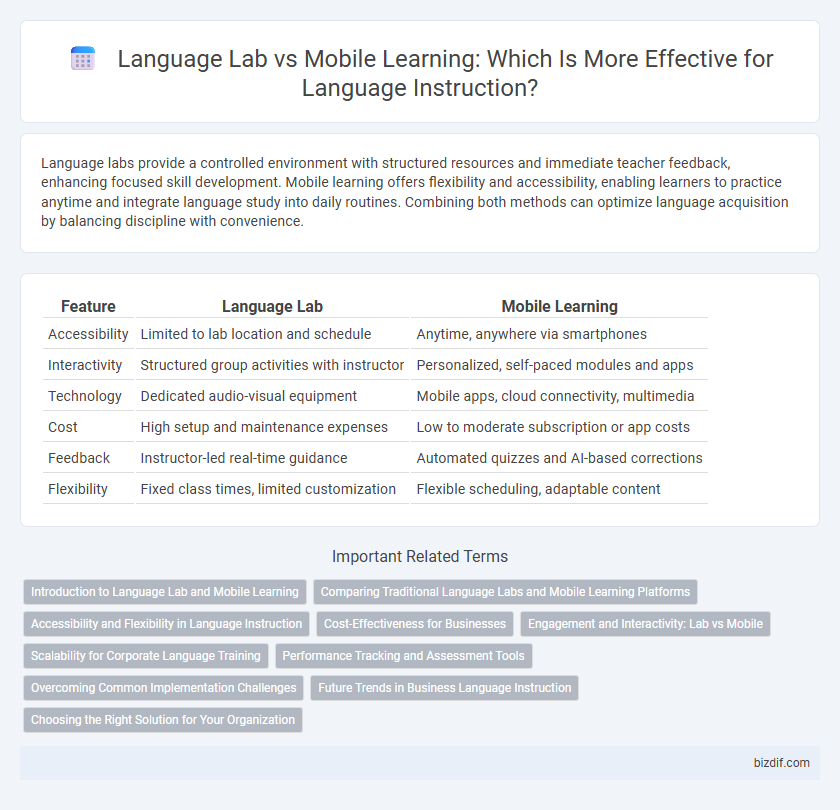Language labs provide a controlled environment with structured resources and immediate teacher feedback, enhancing focused skill development. Mobile learning offers flexibility and accessibility, enabling learners to practice anytime and integrate language study into daily routines. Combining both methods can optimize language acquisition by balancing discipline with convenience.
Table of Comparison
| Feature | Language Lab | Mobile Learning |
|---|---|---|
| Accessibility | Limited to lab location and schedule | Anytime, anywhere via smartphones |
| Interactivity | Structured group activities with instructor | Personalized, self-paced modules and apps |
| Technology | Dedicated audio-visual equipment | Mobile apps, cloud connectivity, multimedia |
| Cost | High setup and maintenance expenses | Low to moderate subscription or app costs |
| Feedback | Instructor-led real-time guidance | Automated quizzes and AI-based corrections |
| Flexibility | Fixed class times, limited customization | Flexible scheduling, adaptable content |
Introduction to Language Lab and Mobile Learning
Language Lab offers a controlled environment equipped with audio-visual tools designed to enhance speaking, listening, and pronunciation skills through interactive exercises. Mobile Learning delivers language instruction via smartphones and tablets, enabling flexible, on-the-go access to lessons, quizzes, and real-time feedback. Both methods integrate multimedia resources but differ in accessibility and user engagement, with Language Labs emphasizing structured practice and Mobile Learning supporting personalized, anytime learning.
Comparing Traditional Language Labs and Mobile Learning Platforms
Traditional language labs provide structured, immersive environments equipped with specialized audio-visual tools and real-time instructor feedback, facilitating focused pronunciation and listening practice. Mobile learning platforms offer flexible, on-the-go language acquisition through interactive apps, adaptive algorithms, and multimedia content accessible anytime, enhancing learner engagement and personalized pacing. While language labs emphasize controlled practice settings, mobile learning prioritizes convenience and continuous accessibility, making them complementary approaches in modern language education.
Accessibility and Flexibility in Language Instruction
Language labs offer structured environments with fixed equipment, limiting accessibility to specific locations and times, whereas mobile learning provides unparalleled flexibility by enabling language practice anytime and anywhere via smartphones and tablets. Mobile learning platforms leverage offline capabilities and adaptive content, catering to diverse learner needs and schedules, fostering continuous engagement beyond traditional classroom settings. The seamless integration of mobile apps with cloud-based resources ensures that learners access up-to-date materials on demand, significantly enhancing accessibility and personalized language instruction.
Cost-Effectiveness for Businesses
Language labs require significant upfront investment in specialized equipment and dedicated space, leading to higher fixed costs for businesses. Mobile learning platforms offer scalable, subscription-based models with minimal infrastructure expenses, enhancing cost-effectiveness for organizations of all sizes. By leveraging cloud technology and BYOD (Bring Your Own Device) policies, mobile learning reduces maintenance and operational costs compared to traditional language labs.
Engagement and Interactivity: Lab vs Mobile
Language labs provide structured environments with specialized equipment that enhances learner engagement through interactive audio-visual tools and real-time instructor feedback. Mobile learning offers flexible access to language practice anytime, fostering continuous interaction via apps with gamified exercises and instant communication features. Combining both methods can maximize engagement and interactivity by blending immersive lab experiences with the convenience and adaptability of mobile technology.
Scalability for Corporate Language Training
Language labs offer controlled environments with consistent audio-visual resources but face limitations in scalability due to fixed infrastructure and scheduling constraints. Mobile learning enables expansive reach across diverse locations and time zones, supporting thousands of corporate employees simultaneously via apps and cloud-based platforms. Scalability in corporate language training is significantly enhanced by mobile learning's flexibility, adaptability, and data-driven progress tracking, surpassing the static capacity of traditional language labs.
Performance Tracking and Assessment Tools
Language labs offer advanced performance tracking systems that provide detailed analytics on pronunciation, fluency, and comprehension, enabling precise assessment of learners' progress. Mobile learning platforms integrate real-time assessment tools and instant feedback mechanisms that adapt to individual learner performance, enhancing personalized learning experiences. Both environments utilize data-driven insights to optimize language acquisition, but language labs tend to feature more structured and comprehensive tracking capabilities.
Overcoming Common Implementation Challenges
Language labs provide structured environments with specialized equipment that can address technical difficulties and foster consistent language practice, overcoming challenges like limited learner engagement and resource constraints. Mobile learning offers flexibility and accessibility, enabling language instruction anywhere and anytime, which helps mitigate issues related to scheduling conflicts and infrastructure limitations. Combining both approaches enhances language acquisition by leveraging the controlled practice of labs and the convenience of mobile platforms, effectively overcoming common implementation barriers.
Future Trends in Business Language Instruction
Language labs are evolving with advanced AI-driven feedback systems enhancing pronunciation and real-time language analytics. Mobile learning leverages app-based platforms, enabling personalized, on-the-go language acquisition with adaptive learning algorithms. Future trends in business language instruction emphasize hybrid solutions combining immersive lab experiences and mobile flexibility to boost engagement and fluency.
Choosing the Right Solution for Your Organization
Selecting the ideal language instruction solution depends on organizational goals, budget constraints, and learner preferences. Language labs provide structured environments with advanced audio-visual tools for immersive practice, while mobile learning offers flexibility, accessibility, and real-time content updates. Evaluating learner engagement metrics and technological infrastructure ensures the chosen method aligns with effective language acquisition and scalable deployment.
Language Lab vs Mobile Learning Infographic

 bizdif.com
bizdif.com